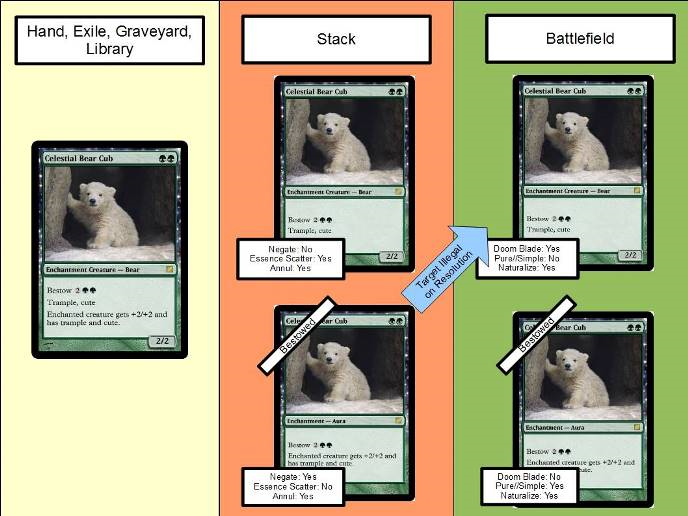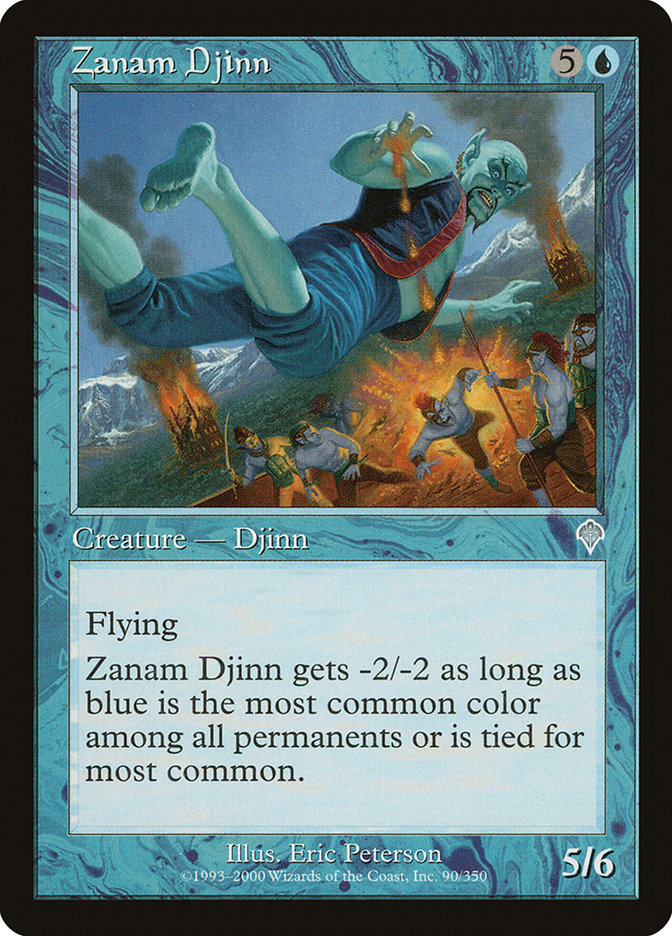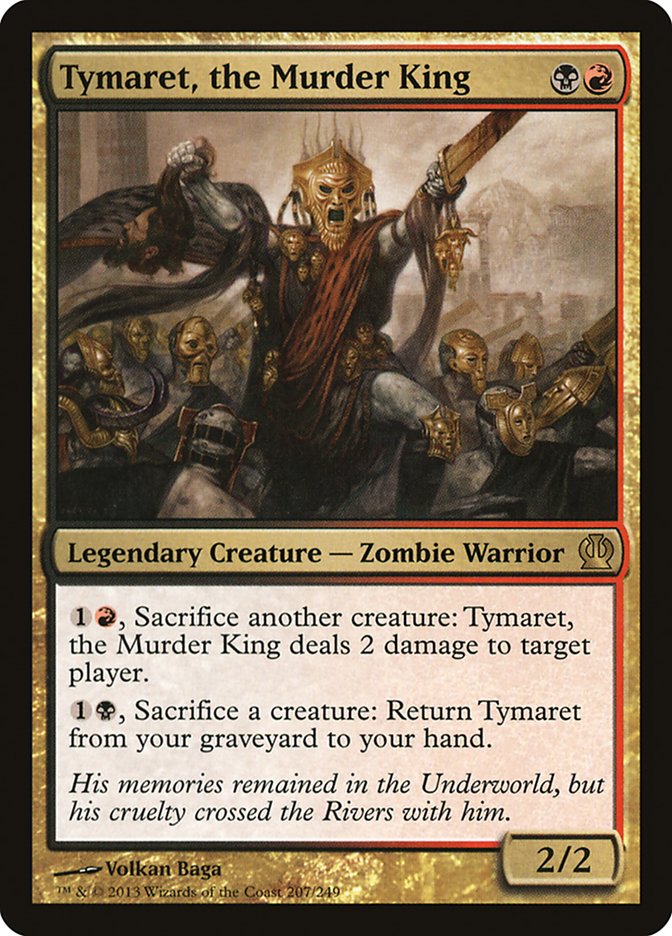Madness isn’t a mechanic in Theros, but the word, not the mechanic, may very well be one of the themes of the set. Card for card, Theros is the most rules-intensive set since . . . I don’t even know. Time Spiral block was a mishmash of past and future abilities, and it took some time to assimilate all of those abilities. Lorwyn block featured the old Mirrorweave / Mutavault interaction along with Snakeform, making the entire block an obstacle course in layers. Those are the first two that come to mind in terms of “judge breakers.”
Theros, the long awaited “enchantment block,” brings with it a lot of excess rules baggage to make things work. Bestow has been the most asked about thing in the set, followed closely by the cycle of Gods. The biggest problem I see from a “grokking” perspective is the juxtaposition of how those two card types act.
Bestow cards are enchantment creatures in all zones except when you cast them for their bestow cost. In that case, they become “enchantment – Aura” with “enchant creature” and lose the creature type altogether (and whatever creature subtypes it has). Once you bestow the card, it will not be a creature until it falls off the enchanted creature. I’ll go a little bit more in depth on that aspect of bestow in a bit.
The Gods are enchantment creatures in all zones except the battlefield because the devotion ability only checks on the battlefield. The devotion ability is not a Characteristic Defining Ability like Tarmogoyf that checks in all zones. Here’s a quick recap of what these two classes of cards look like in various zones:
Graveyard, hand, library, and exile – Bestow cards and Gods are always enchantment creatures.
Stack – Gods are always enchantment creatures. Bestow cards are enchantment creatures if you cast them normally and just enchantments when you bestow them.
Battlefield – Gods might not be creatures depending on your devotion, but they are always enchantments. A bestow card is just an enchantment if you bestowed it and it is attached to a creature. If it is unattached, no matter by what means, it is an enchantment creature.
For the most part, I think the Gods are easier to understand in a vacuum. We’ve certainly had things that change status on the battlefield, such as Rusted Relic. The big difference is that the vast majority of past cards have gained additional attributes based on circumstances rather than lost them, which seems to be a particular sticking point with the Gods. Addition is much easier to understand than subtraction. Once you get used to them, I think it will become more natural to understand that you can search for a God with creature search or counter it with Essence Scatter regardless of your devotion.
I discussed the Gods with some other judges, and Minnesota L3 Rob McKenzie came up with a parallel in the Invasion Djinn cycle.
“Are you a God?”
These cards have a certain printed value but turn off or power down under certain circumstances. I always hated having to a) count permanents and figure out if the power down condition was true and if yes b) doing the math to figure out the new power and toughness of the Djinn. It was a lot of bookkeeping. This is fundamentally much harder to do naturally than thinking about when cards are turned on like with metalcraft. It’s easy as one, two, three.
Bestow cards are another step more complicated than the Gods. For starters, they act contrary to their printed values in two different zones: the stack and the battlefield. The stack has always been a murky zone of confusion. Many players who start out don’t even know that there is a stack. A few days before the Prerelease, many people on Twitter were still quite confused about bestow. When can I Negate the spell? What about Essence Scatter? Are they creatures when they are attached to a creature as an Aura? While questions about mechanics is a common thing leading up to the Prerelease, what made Theros and bestow unusual was that multiple Pro Tour veterans were expressing their confusion.
I poked a little fun at them, but truth be told, I think there is a complexity problem when people who play this game for a living have difficulty with multiple aspects of a new mechanic. That’s a complexity threshold that you rarely want to cross. With that in mind, my good friend at Judgecast, Florida L3 Bryan Prillaman, came up with this handy image to help you out.

Ignore the keyword ability “cute.” Everything else is valid. Bestow cards change from noncreature to creature while moving from the stack to the battlefield. This happens when you cast a spell for its bestow cost but the target creature becomes illegal before the spell resolves (protection, shroud, destroyed, bounced, etc.). Normally, in such a situation, an Aura will go to the graveyard—the classic two-for-one.
The whole point of bestow is to get around this drawback, so what happens is that the bestow card will turn back into a creature and enter the battlefield as such, forgetting about its former attempt to be an Aura. Also, if your bestowed Aura is attached to a creature and that creature gains protection from your Aura’s color, the bestowed card will fall off and become a creature. This was an area of the rules that wasn’t quite clear, although it was clearly how they wanted the cards to work, until the most recent Comprehensive Rules update clarified things.
This chart should serve as an excellent basic guide for how to handle bestow in 99% of the cases you will encounter. What about that other one percent? I really wish you wouldn’t ask, but okay.
When you bestow, you technically start out by casting a creature spell because that is what is printed on the card. Since the base state of the card is that of a creature, when you first put the spell on the stack, it starts out as a creature spell, and it doesn’t become a noncreature until the step in casting a spell where you decide whether to pay it with an alternate cost (this is the same point where you would choose to pitch a blue card for Force of Will). It’s a very small window where it’s a creature spell. Basically, it only interacts with things like Aurelia’s Fury.
If you get targeted with an Aurelia’s Fury during your upkeep, you can no longer cast noncreature spells during your turn. This includes instants, sorceries, and, yes, Auras. However, a bestowed card doesn’t become an Aura until after you have started casting it as a creature spell and then partway through choose to use the alternate bestow cost to change it into a noncreature spell. By then, it’s too late. You started off trying to cast a creature spell, which is all the Aurelia’s Fury restriction cares about.
Strange alchemy also takes place at the opposite end of the stack when the spell tries to resolve. If you cast Doom Blade on the targeted creature, the bestow card will turn back into a creature and enter the battlefield. However, it is at no point a creature spell, meaning you do not get an opportunity to Essence Scatter it while it is on the stack. It is only when it tries to resolve that it will see its target gone and turn back into a creature.
The Best of the Rest
Compared to all this nonsense with bestow, Gods, and enchantments, the other mechanics of Theros seem simple, but it’s worth going over a few things. For example, with heroic, people keep asking about Hidden Strings. This doesn’t work for two reasons. First, Hidden Strings cannot target the same permanent twice. Second, heroic only triggers once per spell.
If you cast a spell targeting a hero, the heroic ability will trigger immediately. Even if the spell is countered, the heroic ability will fire. The converse is true as well. If you target a hero and the hero is killed, the ability has already triggered and will resolve just fine. For many of the heroes this doesn’t matter, but making sure that a Phalanx Leader trigger happens can be the difference between victory and defeat.
Since heroic is a triggered ability, missing it is a thing that can happen. It is important to keep in mind that the trigger always goes on the stack on top of the spell that triggered it. It’s best to cast the spell, say “heroic,” and proceed from there.
Scry is the returning mechanic. Nothing has changed with it since we last saw it, but there are two notable things. First, Flamespeaker Adept only triggers once no matter how many cards you scry in one go. For example, you will only get +2/+0 from casting and scrying with Magma Jet or Read the Bones.
The second thing is gameplay advice. This set has much more of what I call “incidental scrying”—lots of scry 1s attached to other spells (Rage of Purphoros, Battlewise Valor)—as opposed to spells that you are largely casting for their scry effect (Preordain, Foresee). With so many small scrys over the course of the game, I can see it becoming very easy to lose track of how many cards you’ve put on the bottom of your library in a game of Limited. This becomes a problem when you commit a Looking Extra Cards infraction and the judge asks, “Do you know the position of any of the cards in your library?” “Uh . . . I’ve scryed five times, but I don’t remember how many of those are the bottom.” With Prescient Chimera such a stalwart for blue in Theros Limited, that number could easily be two or three times as many scrys.
Keeping track of the number of times you scry something to the bottom of your library, either through a tally on life pad or a “scry die,” could be useful information for judges. No need to keep track of scrys that go on top of your library since you will presumably be drawing those in short order.
Quick Hits
Here are a few interesting rulings from the StarCityGames.com Team Sealed Open in Worcester that I judged this past weekend.
Q. If Artisan of Forms copies another creature with a heroic trigger, will the new heroic ability also trigger from the spell that caused the Artisan to change forms?
A. No. Artisan of Forms must be a copy of the creature when the spell is first cast.
Q. If my opponent has a creature enchanted with a bestow card, can I cast Curse of Swine to turn both of them into 2/2 Boars?
A. No. The bestow card does not become a creature until the creature it enchants leaves the battlefield. It is not a legal target for Curse of the Swine when it is cast.
Q. Can I respond to my opponent activating Nykthos, Shrine to Nyx by removing a creature and reducing their devotion?
A. No. Despite the odd wording, Nykthos’ second ability is still a mana ability and cannot be responded to.
Q. Can Tymaret, the Murder King sacrifice itself to its second ability to return itself to your hand from the battlefield?
A. No. Because Tymaret’s second ability refers to it changing zones from the graveyard, it can only be activated if it is in the graveyard. I think what confuses people is that the ability says “sacrifice a creature” and not “sacrifice another creature” so based on the new sacrifice templating, it seems like you should be able to sacrifice the Murder King to its own ability. Even though there’s no way to sacrifice itself because the ability can only be activated from the graveyard, I think it would have cut down on confusion if it had said “another creature” or “activate this ability only when Tymaret is in your graveyard.” By the rules, either phrase would have been redundant, but sometimes you need a redundancy to cut down on “huh?” moments.
The Big Finish
I want to sign off by returning to bestow real quick. For my entire Magic-playing career, which now spans three decades, three Presidencies, and only one piece of Power Nine ever owned (Mox Ruby), I have always put my Auras (and Equipment) under my creatures in a way so that the name of the Aura is visible directly above that of my creature. I have now seen two different styles of attaching Auras with bestow that I think herald a new direction in card placement. The first is to put the Aura under the creature in a way so that the power and toughness of the bestow card is visible directly below the creature’s power and toughness. This makes it easy to see and add up the power and toughness of the creature, especially if there are multiple bestow cards.
The other method I’ve seen is to attach the bestowed card upside down to the creature so that the power and toughness and extra abilities are readable to the opponent directly above the creature’s name. This is a nice courtesy to the opponent so they can again see and add up the power and toughness and also see those extra abilities you get. And finally, an important thing to remember is that attacking does not cause attached Auras and Equipment to tap. If your bestowed creature dies in combat, your Aura falls off and becomes an untapped creature.
While I’ve tried my best to go over some of the oddities of the set, I find that every conversation I have with someone reveals another confusing point or dark corner of the rules I hadn’t considered. (The interaction with Aurelia’s Fury shocked me.) If you’ve still got questions you want answered, please post them in the comments below. I know that many judges read these articles, and if I don’t get to it first, they will be happy to answer your questions.


